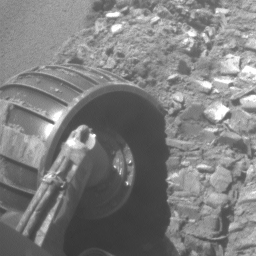This animated piece illustrates the recent escape of NASA's Mars Exploration Rover Opportunity from dangerous, loose material on the vast plains leading to the rover's next long-term target, "Victoria Crater."
A series of images of the rover's left front wheel, taken by the front hazard-avoidance camera, make up this brief movie. It chronicles the challenge Opportunity faced to free itself from a ripple dubbed "Jammerbugt." The rover's wheels became partially embedded in the ripple at the end of a drive on Opportunity's 833rd Martian day, or sol (May 28, 2006). The images in this clip were taken on sols 836 through 841 (May 31 through June 5, 2006).
Scientists and engineers who had been elated at the meters of progress the rover had been making in earlier drives were happy for even centimeters of advance per sol as they maneuvered their explorer through the slippery material of Jammerbugt. The wheels reached solid footing on a rock outcrop on the final sol of this sequence.
The science and engineering teams appropriately chose the ripple's informal from name the name of a bay on the north coast of Denmark. Jammerbugt, or Jammerbugten, loosely translated, means Bay of Lamentation or Bay of Wailing. The shipping route from the North Sea to the Baltic passes Jammerbugt on its way around the northern tip of Jutland. This has always been an important trade route and many ships still pass by the bay. The prevailing wind directions are typically northwest to southwest with the strongest winds and storms tending to blow from the northwest. A northwesterly wind will blow straight into the Jammerbugt, towards shore. Therefore, in the age of sail, many ships sank there during storms. The shore is sandy, but can have strong waves, so running aground was very dangerous even though there are no rocks.
Fortunately, Opportunity weathered its "Jammerbugt" and is again on its way toward Victoria Crater.

 Planetary Data System
Planetary Data System












